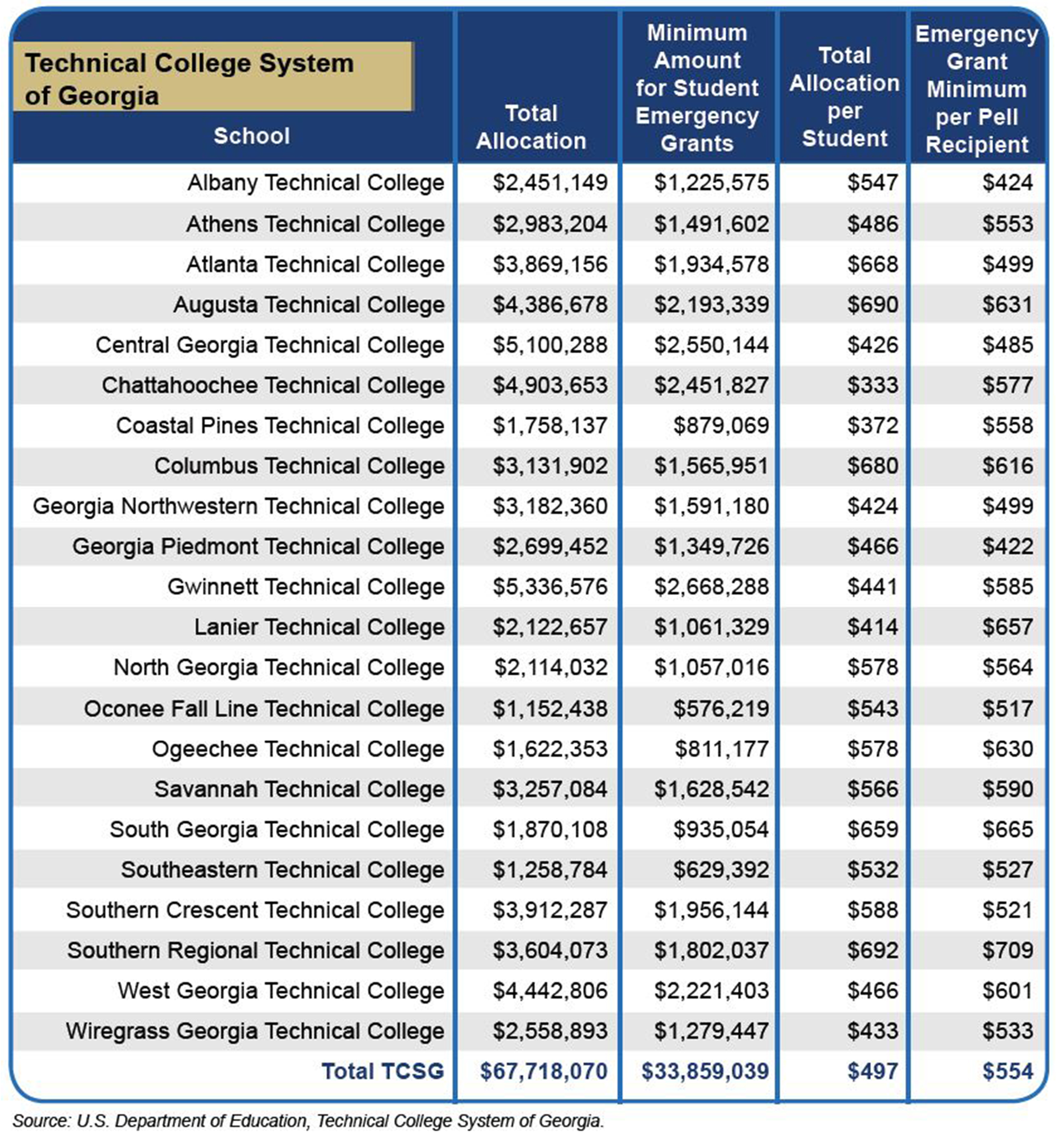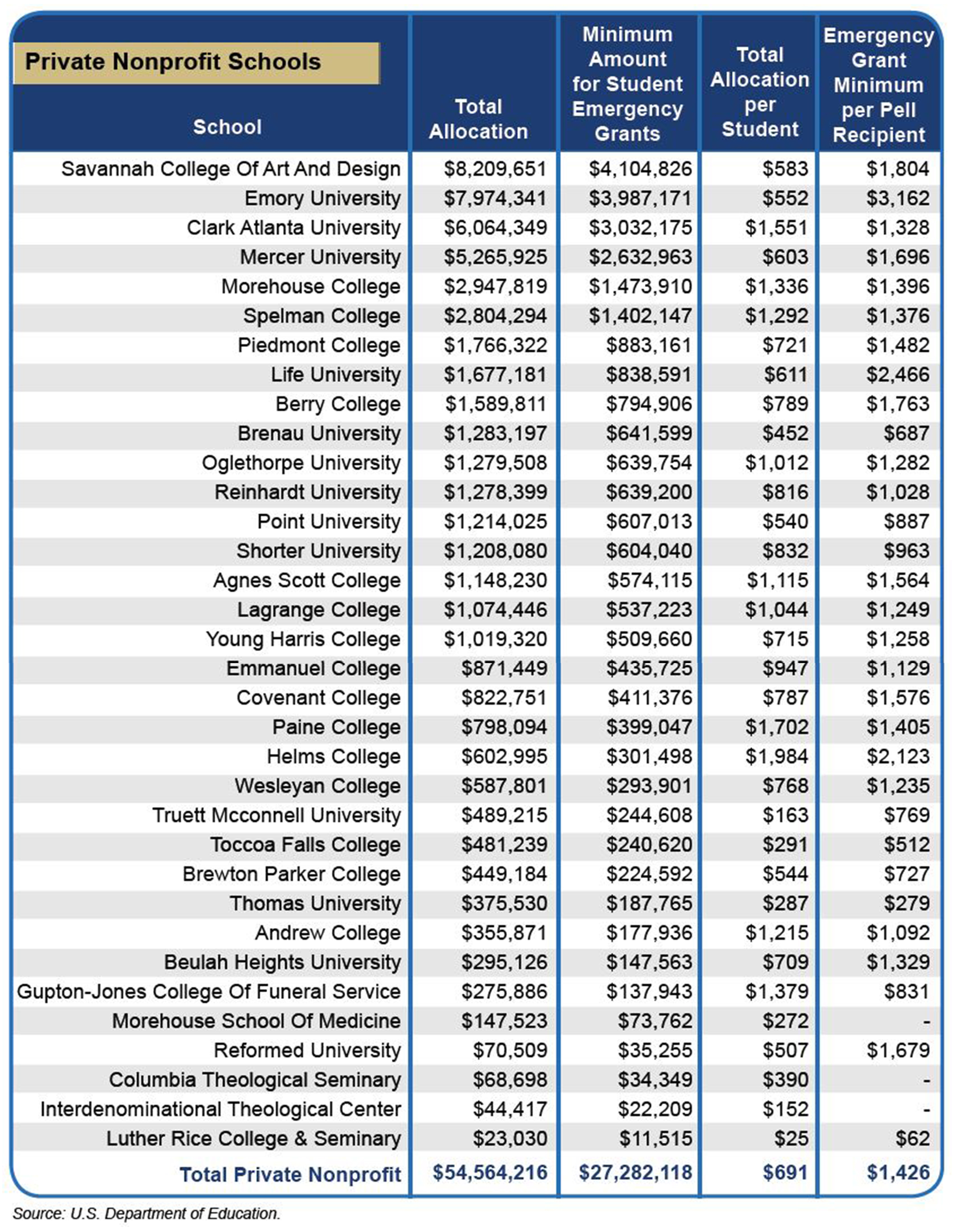Since publication of this blog post, the federal Department of Education allocated a second pot of relief dollars for Historically Black Colleges and Universities, Minority Serving Institutions and other institutions with a substantial number of students with financial need. Download Georgia allocations.
The federal Coronavirus Aid, Relief and Economic Security (CARES) Act will make $406 million available to Georgia colleges and universities through the Higher Education Emergency Relief Fund. Half of the funds are available now to colleges to distribute directly to students as emergency grants. Colleges have one year to distribute the funds after receiving them.
Although the relief fund will help support many college students, the CARES Act did exclude them from so-called “recovery rebates.” Students whose parents list them as dependents on tax forms are not eligible for payments, nor are students classified as “independent” but who did not file taxes in 2019 or 2018 or immigrant students who file taxes without a Social Security number. Students who are eligible but do not have direct deposit information with the IRS will be among the last to receive their rebate.
Even before the pandemic, financial need among college students was very high. The University System of Georgia estimated $808 million of unmet financial need among their students in 2014-2015. In listening sessions, students consistently describe financial insecurity as a major challenge. Nearly 40 percent of students in the university system experienced challenges affording and accessing consistent food and housing before COVID-19.
Forty-two percent of students did not receive financial support from family to help pay for college or living costs. Nearly 60 percent worked before the current unemployment crisis. Students sometimes describe providing financial resources or other supports, such as transportation, to family members. Undocumented students may face additional burdens, as they pay tuition rates two to four times higher than their peers and are ineligible for Pell Grants and federal loans.
About $203 Million Available for Emergency Grants Statewide
The Higher Education Emergency Relief Fund is a way for colleges to direct stimulus money to students who struggle with basic needs and to help keep them enrolled in school during this challenging time.
At least half of relief funds must be awarded directly to students as emergency grants. The 50 percent minimum allocation for student grants is available now; the remaining 50 percent, which can be used for costs associated with moving instruction online and other expenses, is forthcoming.
Colleges can develop their own processes and criteria for getting funds and awarding money to students. Many colleges already have emergency grant funds and processes due to pre-existing student needs. The only requirement for new federal relief funds is that they are used “to help cover expenses related to the disruption of campus operations due to coronavirus,” such as food, housing, course materials, technology, health care and child care.
These relief funds are not enough to meet all students’ financial needs. The pandemic has exposed and exacerbated existing challenges, and it will be difficult for colleges to disentangle pre-existing needs from those brought on by coronavirus. Schools should instead focus on setting up simple processes so students can meet basic needs and stay enrolled.
Total Allocations Average Less than $1,000 per Student
Overall, $406 million will flow to Georgia colleges and universities, and $203 million will go directly to students. Hundreds of thousands of Georgians are pursuing postsecondary education and training. The minimum in emergency student grants comes to about $374 per student, or $1,152 per Pell recipient, who were weighted differently to serve as a proxy for students from families with low incomes. Because of this, colleges of similar sizes may get different amounts of relief funds if their students come from different economic backgrounds.
The Department of Education said it determined allocations based on schools’ relative share of Full-Time Equivalent (FTE) undergraduate Pell Students and total FTE undergraduate and graduate students. Total allocations by sector are:
- University System of Georgia – $256 million, or $749 per student
- Technical Colleges – $68 million, or $497 per student
- Private Non-Profit Colleges – $55 million, or $691 per student
*Board of Regents includes Georgia Military College. Averages presented are for fall snapshot enrollment, not FTE. Private for-profit colleges in Georgia are allocated $28 million.
Allocation data from U.S. Department of Education. Per-student numbers calculated using Fall 2018 enrollment and Pell recipient data. More details follow.
















